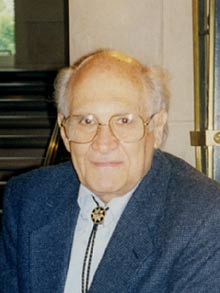Berkeleyan
Obituary
Lawrence W. Stark
![]()
04 November 2004
 Lawrence Stark (Photo courtesy of the Stark family) |
A neurologist by training, Stark conducted groundbreaking research that applied engineering principles, particularly control theory, to biological systems.
“Stark was unique in his ability to identify aspects of engineering analysis relevant to medicine and biology,” said Laurence Young, Apollo Program professor of astronautics at the Massachusetts Institute of Technology and Stark’s first graduate student at MIT. “A perfect example is the seminal work he conducted in analyzing the way a pupil reacts to light in terms of a linear control system.”
Young pointed out that those same principles have been applied to such areas as pilot control of airplanes and spacecraft. “Characterizing how the eye moves and how the brain processes visual cues is essential to understanding how pilots control airplanes, and why people get motion sickness,” he said.
In addition to analyzing the feedback control system governing pupil contractions, Stark also developed the scan-path theory of eye movements. He studied the way people’s brains viewed the world and analyzed the vast number of jumping eye movements, or “saccades,” people make. He noticed specific sequences to how people glimpsed a room, face, or other scene before them, and realized how those sequences provided clues to the importance of pictures generated by the brain.
Stark’s drive to understand visual processes within an engineering discipline led to his later research interests in robotic vision and virtual reality.
“Although he was trained in medicine, he was very interested in the physical sciences and engineering,” said professor of neurobiology Gerald Westheimer. “He was a true crossover scientist, bringing applied engineering concepts to neurological functions, and the variables inherent in biology to engineering.”
Born in New York on Feb. 21, 1926, Stark credited his early interest in engineering to the influence of his father, an MIT-educated chemical engineer. After receiving his bachelor’s degree from Columbia University in 1945 he joined the military, taking the U.S. Navy up on its offer to pay for his medical-school tuition. Stark went to New York’s Albany Medical College, where he earned his M.D. in 1948.
He then spent two years in England at Oxford University and University College, conducting research in neurophysiology, biochemistry, and biophysics, before returning to the U.S. Navy to serve as a doctor during the Korean War. In 1954 Stark joined Yale University as an assistant professor of medicine.
In 1960 he became head of the neurology section of MIT’s Center for Communication Sciences, and in 1965 he founded and became chairman of the Biomedical Engineering Department, one of the country’s first bioengineering departments, at the University of Illinois at Chicago.
Stark joined the Berkeley faculty in 1968 with joint appointments as professor at the School of Optometry, the Department of Electrical Engineering and Computer Sciences and the Department of Mechanical Engineering. He also collaborated on neuro-ophthalmology research with colleagues at UC San Francisco. He retired from Berkeley in 1994, but remained active in his lab on campus.
Stark received numerous honors throughout his career, including an honorary Sc.D. from the State University of New York and an honorary Ph.D. from Tokushima University in Japan. He was named a Guggenheim Fellow in 1968, a fellow of the Institute of Electrical and Electronics Engineers in 1970, a recipient of the William J. Morlock Award in Biomedical Engineering in 1977, and a fellow of the American Institute of Medical and Biological Engineering in 1992.
A transcript of Stark’s interview with Harry Kreisler of the Institute of International Studies is online at globetrotter.berkeley.edu/conversations/Stark/stark-con0.html.
Stark is survived by his partner of 18 years, Jill Strohn of Berkeley; three daughters, Stefanie Stark of Kensington, Nanou Matteson of Berkeley, and Elizabeth Stark of San Francisco; Elizabeth’s mother, Wendy Bartlett of Berkeley; ex-wife, Jeanne Stark-Iochmans of Berkeley; his brother, Matthew, of Minneapolis; and four grandchildren.
Stark’s first wife and Stefanie’s mother, Jane Stark, died in 2001.
Memorial services at the Faculty Club are being planned. When the exact date and time are available, they will be posted online at scan.berkeley.edu/larry. In lieu of flowers, donations in Stark’s memory can be made to the Golden Gate National Parks Conservancy, Fund in Memory of Lawrence W. Stark, Attn: Audrey Yee, Fort Mason Building 201, San Francisco, CA 94123-0022. In accordance with Stark’s wishes, the money will be used to purchase land that will be kept preserved and open to the public.
—Sarah Yang

